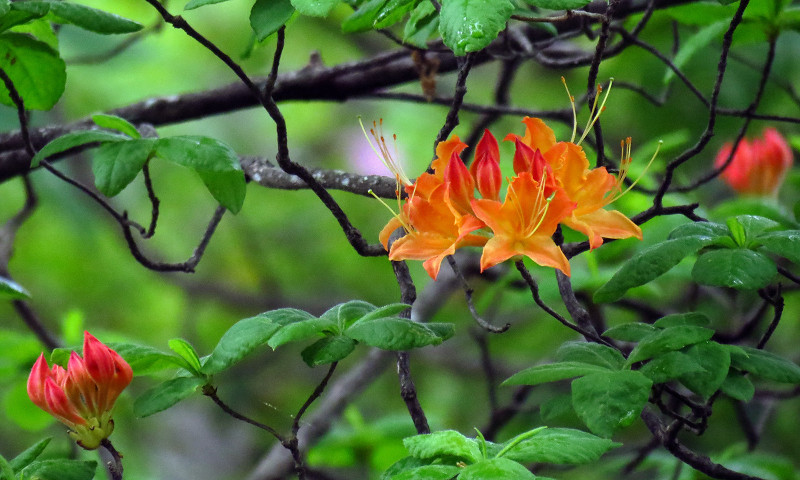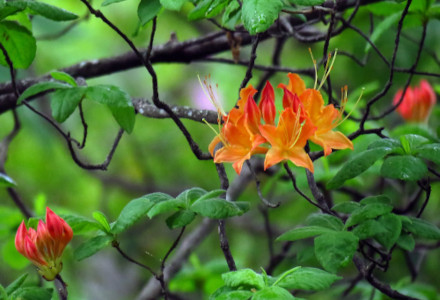
Photographer: BlueRidgeKitties
CC License: https://bit.ly/36GGrWt
Flame Azalea Facts
- This magnificent creation of Nature and evolution most frequently and wholly understandably, goes by the common name of the Flame Azalea. It’s scientific name, however, is the extremely hard to pronounce term of Rhododendron calendulaceum.
- Perhaps most notably, the mesmerizing Angiosperm stands out from the majority of related species for its exquisite beauty. That occurs partly due to its famous, among Nature lovers, at least, wonderful large, showy, funnel-shaped flowers.
- These incredible flowers conceal a few remarkable secrets, however. For one, these blooms actually develop almost entirely without scent. Among similar related species, this stands out as a surprising difference, given the strong fragrance of the others.
- Its beautifully colored blooms sometimes actually appear either before the leaves do, or simultaneously with the leaves and the flowers. Very few flowering plants display that tendency. This represent yet another manner in which it distinguishes itself.
- The great beauty conceals one more secret, and a dark one. That holds true due to the fact that all parts of the Flame Azalea evolved as highly toxic. In fact, its toxicity remains so great, honey produced by bees from these plants may be fatal to humans.
- Fortunately for it, though, the beautiful plant appears to be maintaining a population base that’s both stable and sufficient. This trend also seems to hold true throughout the entirety of its native range. The IUCN, therefore, currently has no listing for it.
Related Articles
Gympie-Gympie Kurinji Dragon Fruit
Public Domain Image
Flame Azalea Physical Description
The stunning Flame Azalea represents a stunningly beautiful upright-branched deciduous shrub. It also impresses due to it sheer size. This marvel of evolution also generally, under favorable conditions, at least, attains a much larger physical size than related varieties.
In fact, some specimens of the visually impressive flowering species attain heights measuring up to as much as a remarkable12 ft (3.65 m). Its impressive physical statistics, however, do not simply end with its mere height. It has yet more wonders to amaze us with.
That’s because, due to its somewhat unique growth patterns, individual plants often measure as much in width as they do in height. This attribute alone distinguishes it from many relatives. The remarkable work of Nature thus develops a truly impressive appearance.
The lovely foliage of the Flame Azalea typically develops as a dark green. Meanwhile, the copious numbers of flowers it produces vary in color across a range of shades of orange and red. These numerous flowers also typically develop in clusters of five or more.
- Kingdom: Plantae
- Phylum: Angiosperms
- Class: Eudicots
- Order: Ericales
- Family: Ericaceae
- Genus: Rhododendron
- Species: R. calendulaceum
Flame Azalea Distribution, Habitat, and Ecology
Regrettably, the magnificent Flame Azalea inhabits a very limited portion of the globe. That’s due to the fact that it evolved as native to a rather specific region of the world. That area consists solely of a small portion of the United States, in North America.
It’s habitation range restrictions do simply end there, however. In this instance, the very nature of the evolutionary wonder work against it. That’s because that restricted territorial range consists only of the southern portions of the Appalachian Mountains.
But, even there, this variety of Rhododendron possesses highly specific requirements. This holds true because it most commonly appears in the numerous grassy balds that dot the surrounding region. There, it easily creates a striking visual display for all.
Although somewhat less commonly, it also appears in areas of woodland. Not content to rest, it seems Nature provided it yet another distinction. Much like most members of the heath family, this amazing beauty grows most prolifically in acidic soil.
This somewhat uncommon trait helps the dazzling, if complicated, Flame Azalea, thrive in otherwise inhospitable regions. For reasons that remain undetermined, the plant further appears to be a particular favorite of the Golden Northern Bumblebee.
Species Sharing Its Range
Opossum Eastern Tent Caterpillar Carolina Silverbell
Check out our other articles on Earth’s Many Mesmerizing Cephalopods, Tawny Frogmouth, Blood Falls, African Bush Pig, Bosnian Pine, Marine Iguana, Giant Atlas Moth

